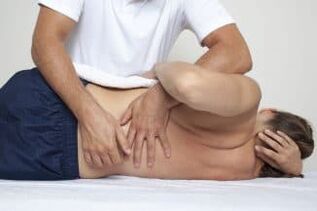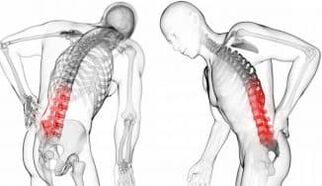Osteochondrosis is a dystrophic change in cartilage that occurs due to aging processes and negative external exposure.Most often, it appears in intervertebral discs, so the most common types of osteocondrosis are lumbar houses and chest.The lumbar osteocondrosis leads to the appearance of pain and curvature of the spine, so you need to start high quality and qualified treatment as soon as possible.In the article we will consider the most important symptoms and methods of treating osteochondrosis of the lower back.
Description of the disease
Osteocondrosis in the lumbar area is characterized by dystrophic changes in the intervertebral discs(Thinning, deformation, loss of elasticity).As a result, pain, performance and mobility occur.Not a single person is protected from the disease.The human spine is constantly experiencing a vertical load.Side effects (sedentary lifestyle, excessive physical activity) only aggravate the situation.A certain percentage of people after 30-35 years begin to experience discomfort in the lumbar area.
The reasons for the development
There are many factors that can cause osteocondrosis.Most often, the disease occurs due to disposal and uneven load on the spine.In addition, the causes of dystrophic changes in cartilage: Become: Stay:
- A sedentary lifestyle;
- presenceScoliosis;
- Weak muscle tone;
- constantStress;
- Lack of micro and macro elements in nutrition;
- ProfessionalGreat sports.
The presence of the above factors in a person's life increases the likelihood of osteocondrosis significantly, even at a relatively young age.
Symptoms
The biggest symptom of the disease is pain in the lumbar area.The following manifestations occur depending on the lesion stage:
- The first phase-Learly complete absence of signs, fatigue may occur;
- The second phase- Periodic pain in the crucifix;
- The third phase- constant pain, curvature and the appearance of a hump;
- The fourth phase- Expressed pain syndrome for any movement, displacement of the vertebrae.
Osteochondrosis is quite easy to determine at the main symptom.If a person periodically encounters pain in the crucifix, visit a doctor.
On the fourth phase of the disease, a person can completely lose work ability and become a disabled person.
Diagnostics
To identify the disease, hardware studies and diagnostic tests are used.First of all, the doctor conducts a visual examination and testing.It is important to exclude diseases with similar symptoms.To determine the degree of damage is used:
- Mr;
- X -Ray;
- Ct.
After examining and performing various tests, a preliminary diagnosis is made.Using a hardware examination, it is possible to accurately establish the cause of discomfort.Osteochondrosis on the first step can only be detected by means of calculated or magnetic resonance image.
Reflex Lacega
Lacega reflex is a symptom that is only detected with neurological and dystrophic pathologies in the spine.The presence of the Bages reflex is determined by the neuropathologist.This happens as follows: A person accepts the position of lying;The doctor raises the straightened leg up.If a person has more than 30 degrees when raising a leg occurs, pain occurs, the test is considered positive.For the test, no special devices are required, so it is performed even during the initial examination.
Correct a test to identify the symptom of lasaga only one doctor.Using this test you can almost accurately determine the damage area.
Knee reflex
This sample is almost always performed by an initial inspection.The essence of the reflex is that if a person is pressed by directed knees to a flat surface, he has pain syndrome.It is worth noting that this test is not always positive with dystrophic changes in the intervertebral disks, but it does not take much time to spend.With a positive result, the doctor may be able to make a preliminary diagnosis of osteochondrosis.
Hardware methods
Hardware studies are the most effective for diagnosing osteocondrosis.Computer or magnetic resonance image is used.An X -Ray examination of the lumbar area will also help make a diagnosis.These methods allow you to evaluate the degree of damage and the distance between the vertebrae.In addition, with their help, complications can be diagnosed that often occur during illness (hernia, curvature).
Treatment
Treatment of osteochondrosis must be complex.When therapy you must comply with the following principles:
- Exclusion of provocative factors;
- Eliminating related pathologies;
- removal of inflammation;
- Stimulating the restoration of cartilage.
The success of the treatment depends not only on the doctor but also on the person.It will be necessary to observe the regime, participate in physical therapy exercises, go to physical therapy.Part of the medicine is only used in the emergency period.
Throughout therapy, it is necessary to exclude vertical loads on the spine as this can aggravate the pathology.
Medicine
Medicine is used during the acute period of the course of the disease.The main task is to get rid of pain and inflammation.For this, drugs in the form of ointments, injections and tablets can be used.The following classes of medications are used:
- Analgesics;
- Non -steroidal anti -inflammatory;
- Chondroprotectors;
- muscle relaxants;
- Vasodilators.
Specific drugs are chosen by the doctor.Injection of NSAIDs into the affected area will help relieve pain quickly.Chondroprotectors will contribute in a stop of dystrophic changes and will launch the recovery process.Using medication you can effectively fight osteocondrosis in the first and second steps, more complex treatment methods are used for more complex cases.
Physiotherapeutic procedures
Physiotherapy helps to get rid of less pain and consolidate the result of drug treatment.The following procedures are used:
- Fonophoresese;
- Magnetotherapy;
- Effect of vibrations;
- Dutoenzor therapy.
Most procedures can only be performed during remission.The moment when using physiotherapy is most appropriately determined by the doctor.To achieve the therapeutic effect, you must regularly visit the physical therapy.At least 7-10 procedures are required to achieve sustained improvement.
Manual therapy

Using manual therapy it is possible to get rid of stiffness, muscle spasms and pain.A direct effect on the affected area with hands allows you to create conditions for quick restoration of the spine.With osteocondrosis, it is possible to remove the load that may occur due to incorrect attitude.The manual specialist acts on the lower back and the whole back with massage movements.The effect of manual therapy can be seen after several procedures.
Manual therapy should only be performed by a qualified specialist who has all the necessary certificates.The wrong influence on the spine aggravates the situation.
Medical physical exercise
A person with osteocondrosis should strive to correct attitude and strengthen the muscle corset.The LFK complex can be used during remission.The following exercises can be performed:
- Knees and put the weight that lies.Perform the head and bend the crucifix, then lower your head and return to its original position.Repeat 8-10 times.
- Lie on your back.Alternatively bend the legs of the knee joint.Repeat 10-12 times.
When the muscles are strengthened, the load may rise.Static exercises can be used to strengthen the loin muscles.A specific complex is selected based on the individual properties of a person and the degree of lesion of osteocondrosis.After achieving lasting remission, continue to participate in physical training.This is one of the best prevention of the disease.
Folk recipes
Different natural compresses can be used to relieve pain and inflammation.Among the most effective recipes is highlighted:
- Compression from mustard and vodka.It requires 50 g of dry mustard, 100 ml vodka and 50 ml Campaire alcohol.The components are mixed and insisted for 10 hours.A cloth is moistened in the resulting liquid and applied to the affected area for 20-25 minutes twice a day.The course of treatment is 7-10 days.
- Compression of raw potatoes and honey.Clean and grind the potato, then mix it with honey.Put the resulting consistency in the lumbar range, deck with polyethylene and fix it.The compress is stored for 30-45 minutes.
Heating of compressions will help get rid of pain.Persistent improvement is possible when combining with other treatment methods.
Surgical intervention
Surgical intervention is an extreme measure used in the case of irreversible changes in the tissues.Using the operation, the cause of pain is removed.Most often, a discoctomy is performed in which the intervertebral disk that compresses the nerve is partially or completely eliminated.A specific type of surgical intervention is selected individually.It is worth noting that it is quite difficult to perform any surgery on the spine.
The therapeutic effect of a single surgical intervention is not always achieved.If a person drawn with treatment for a long time, more operations may be required.
Prevention
A person can easily prevent or stop the development of osteocondrosis using prevention.The following actions required:
- useOrthopedic mattresses and pillows;
- Follow the attitudeEspecially with a sedentary lifestyle;
- useExercise therapy;
- Engage in swimming;
- Balanced to eat;
- Visit Masseur.
It will also be necessary to regularly undergo preventative studies using modern hardware methods.And with a disposal for osteocondrosis, it is desirable not to engage in serious sports.This applies to the prevention of not only osteocondrosis in the lumbar spine, but also intervertebral osteochondrosis in the thoracic region.
Possible complications

First and foremost, osteochondrosis of severe pain is worsened.During the development of the disease, the distance between the vertebrae decreases.In the end, this leads to a clamp of the nerve and acute pain syndrome.In addition,The following complications can appear:
- projection;
- Intervertebral hernias;
- Violation of the blood supply to the spinal cord;
- paralysis.
The earlier a person begins treatment, the less likely to have met any complication of osteochondrosis.The most dangerous are the protrusion of cervical osteocondrosis, but that does not mean that in the lumbar area they are less dangerous.
Conclusions
- Osteochondrosis is a degenerative disease where the elasticity and mobility of the spine are lost.
- The disease is launched on the basis of low activity, severe scoliosis or due to an unbalanced diet.
- With a competent therapeutic approach, you can completely stop the development of dystrophic changes.However, serious forms of the disease are treated through surgical intervention.
- For prevention, it is necessary to lead a healthy lifestyle, monitor attitude and avoid heavy stresses.
- If you start the course of the disease,There is risk of serious complications up to paralysis.



























